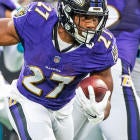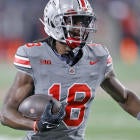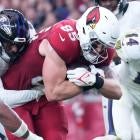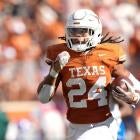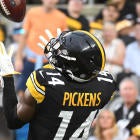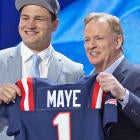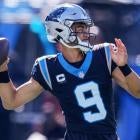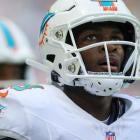Tuesday, I went over five big questions in the NFC that could shape the 2019 Fantasy season, questions I came across while doing my projections. One big advantage of projections is understanding where opportunity might exist that is not being identified by ADP. But that doesn't mean everything is cut and dry, and considering alternate scenarios can mean the difference between being over-reliant on a single expected outcome and identifying a big breakout.
Let's discuss five big questions from the AFC:
1. What will the running back workload splits be like in Kansas City?
The success of Andy Reid's running backs is well known. Just in the last couple seasons, Kareem Hunt finished as the PPR RB4 in 2017 and the team's running backs combined to finish with the fifth most PPR points of any team in 2018.
A major element of Reid's running back success has been receiving production, from Brian Westbrook through LeSean McCoy and Jamaal Charles all the way up to Hunt. Williams may not be on their level as a player -- though his 95th percentile speed score, per PlayerProfiler, has always suggested latent upside -- but what he's always done well is catch the ball.
During his four seasons in Miami, Williams notched at least 20 receptions each year and posted an above-average 6.4 yards per target (for reference, league average running back yards per target over the past three seasons is 6.0). Last season, including the playoffs, Williams caught 33 of 38 targets for 6.6 YPT and four receiving scores.
By comparison, Carlos Hyde has never been a good receiver, despite a 59-catch season in 2017 with San Francisco that has given him a bit of a reputation as one. His career YPT is a putrid 4.0, and his volume in 2017 was almost entirely due to poor quarterback play, as an overmatched C.J. Beathard checked down to him 50 times in six games, 20 more targets than any other 49er saw from Beathard, and a number that accounted for more than half of Hyde's receiving volume that year. In two stops last year, Hyde caught just 10 total passes against 172 total rush attempts.
There are of course other backs on Kansas City's roster, and rookie sixth-round pick Darwin Thompson in particular flashed as a receiver at Utah State last year. But the biggest knock on Williams is a lack of track record, and Hyde is the only back on the roster who can lay claim to more experience.
Since I feel confident Damien Williams' skill set is a much better fit for Andy Reid's scheme than that of Carlos Hyde, I came out with a pretty optimistic projection. Even if this is more of a timeshare than Reid's history suggests he prefers, Williams will likely be on the field for the majority of early-season passing downs, and that alone should give him a reasonably stable floor, something his history (zero seasons with even 100 touches) would suggest he lacks.
2. How will the Steelers replace Antonio Brown?
This one could go a lot of ways, but I'm a big believer in JuJu Smith-Schuster, and I'm expecting him to dominate targets similar to how Brown himself has for several seasons in Pittsburgh. Of course, the fact that Smith-Schuster earned 166 targets last year even with Brown on the roster helps that interpretation.
What's interesting is no Steelers wide receiver or tight end outside of Brown saw 100 targets in any of the four seasons prior to 2018. Even when Martavis Bryant peaked at WR39 in PPR leagues in 2015, he did it on 92 targets. You have to go back to Emmanuel Sanders' last season with the Steelers in 2013 to find a second receiver cresting triple-digit volume.
Of course, Le'Veon Bell played into that. Bell surpassed 100 targets twice, and hit 94 another time. It's no coincidence Bryant's peak coincided with Bell missing 10 games in 2015, as DeAngelo Williams, Bell's replacement that season, totaled just 47 targets. But last season, James Conner and Jaylen Samuels combined for 100 targets exactly, and I've again projected the Steelers' backs to combine for over 100 in 2019, particularly because Samuels is an accomplished pass-catcher and I expect him to be more involved throughout the duration of the season than he was in 2018.
The Steelers led the league with 689 pass attempts last year, and while we should expect some regression there, they were the only team with a bottom five rush percentage that actually had a positive average game script. In fact, the other four teams with low rush percentages were all at minus-two or worse, meaning that on average, at any moment in any of their games last year, they were trailing by more than two points. By comparison, the Steelers seemed to throw as much as they did more by design than because game situations dictated it.
I have the Steelers leading the league in pass attempts again this year, just ahead of the Colts and Buccaneers, and JuJu Smith-Schuster leading the league in targets. I have him ranked WR2. Because I think the rest of the work might be split more than Fantasy gamers would like, including guys like Ryan Switzer essentially matching his 44 targets from last year (I bet you didn't know Ryan Switzer had 44 targets last year; I sure didn't), I have James Washington at 93 targets, which puts him in my WR4 range. Vance McDonald, though, comes out as a low-end top 10 tight end on 81 targets as the third option.
3. How much will Lamar Jackson run?
The Ravens are impossible to project. Last season, only three running backs averaged more carries per game than the 17 Lamar Jackson averaged in his seven regular season starts. We're talking about a 272-carry pace over 16 games. For a quarterback.
A couple things. First, the Ravens went 6-1 in those games, with their only loss coming in overtime by three points to a Chiefs' team they tried to beat by controlling the clock, meaning they were in almost no obvious passing situations.
Second, in his one playoff game, a loss to the Chargers that included a double-digit deficit for much of the second half, Jackson threw a season-high 29 passes and ran just nine times. He did take seven sacks, though, and their passing offense struggled mightily until a late surge, so that game isn't a great barometer of what they'd like to do.
I think there's a reasonable case to be made that a healthy Jackson who plays 16 games will run anywhere from 120 to 220 times this season. The team has been saying the right things about throwing more, but players are who they are and Jackson is a frankly dynamic rusher who averaged over 100 rushing yards per game and 218 rush attempts per year -- in 12- and 13-game seasons -- in three years as a starter at Louisville. The actual range on how much he could run in 2019 is might actually be even larger than I've laid out.
And that's a big deal! Last year, the average team ran 1,007 plays, meaning my rough estimate constitutes roughly 10% of the team's total plays for the season. Quarterback rushes, of course, help no one else statistically. They may improve the offense's efficiency overall, but on those specific plays, nobody is catching a pass and nobody else is recording a rush attempt.
Last season, the Seahawks became the first team in three years to record a rush attempt on more than half their overall plays. After settling on 182 rush attempts for Jackson, I'm projecting the Ravens to do that in 2019. I have Marquise Brown leading the team with 90 targets, and I have enough of a split among the running backs that I only have Mark Ingram at 186 touches as the team leader. I like Jackson this year, but outside some late stabs on guys like Justice Hill, I'll be mostly avoiding their skill position players in drafts.
4. Who will catch touchdowns for the Chargers?
Mike Williams emerged in his second season, and he did so thanks to 10 touchdowns on just 66 targets, a ridiculous 15.2% touchdown rate. Hunter Henry is back, and the strength of his first two seasons in 2016 and 2017 was his ability to score at a high rate, with an also ridiculous 10.4% touchdown rate (12 on 115 targets).
Meanwhile, Melvin Gordon and Austin Ekeler combined for seven touchdown receptions in both 2017 and 2018, continuing a trend throughout Philip Rivers' career of Rivers finding his backs in the scoring area, something that helped Danny Woodhead post six receiving touchdowns in both of his two healthy seasons with the Chargers.
I haven't even mentioned their No. 1 receiver!
What does all this mean? Well, Rivers is surrounded by so much talent he's again a solid Fantasy option, although he adds nothing on the ground that limits his upside. He's a better target in leagues that award six points per passing touchdown.
Also, Williams and Henry probably can't both be breakouts. And if they are, things have gone awry for Keenan Allen, who for his part probably won't be seeing an increase in scoring anytime soon. That's not the worst thing for him, since he's such a stable producer of receptions and yards. But Allen is enough of a target hog, and the backs involved enough in the passing game, that even with the departure of Tyrell Williams, it's hard to see Mike Williams and Henry seeing the necessary volume increase to offset expected regression in their touchdown rates.
Bonus question for the Chargers: Will Justin Jackson play a decent amount as the No. 3 running back? Melvin Gordon has now missed December games in three of four seasons, and the Chargers have more depth behind him than they've ever had after Austin Ekeler posted a second strong season and Jackson played well after Ekeler was also injured. It makes too much sense for the Chargers to not be thinking long and hard about making room for both Ekeler and Jackson to spell Gordon in 2019 when possible, which could limit Gordon's touch upside.
5. How much will Josh Jacobs play on third downs?
The Raiders used a first-round pick on Jacobs, and that typically indicates a desire to feature a running back. Plus, Jacobs was a solid receiver at Alabama, catching 48 passes for 571 yards and five scores over three years.
But it also doesn't seem that simple. Jalen Richard was excellent as a pass-catching back in 2018, pulling in 68 of 81 targets and leading the team or tying for the team lead in receptions in a whopping seven games. And he made plays with those receptions, posting 7.5 yards per target to raise his career number to 6.8. He has also averaged 5.3 yards per carry on 194 attempts in his career.
Jacobs is clearly the man here, but Richard is an underrated talent, and receptions are the big sticking point here. For Fantasy, especially in PPR leagues, running back production is most heavily tied to receptions and touchdowns. And while good players do rip off long touchdowns, those are overwhelmingly scored close to the goal line.
Though they've definitely added some pieces, the Raiders might not have a great offense, so capping off enough drives to reach double-digit touchdowns might be a reach for Jacobs in Year 1. If Richard is playing more on passing downs, you're talking about a statistical profile for Jacobs that isn't conducive to Fantasy success. A lot of empty carries between the 20s does not a Fantasy stud make.
I'm open to being wrong here, but especially because Jacobs wasn't a workhorse in college -- instead splitting reps with Patriots' draft pick Damien Harris -- I have a hard time seeing him be a three-down back for 16 games at the NFL level, at least not from Day 1. And since his backup is such an efficient player in the passing game, I'm projecting him to lose quite a bit of work there, which has me mostly avoiding him in drafts.
So what 2019 Fantasy Football sleepers should you snatch in your draft? And which RB2 can you wait on until late? Visit SportsLine now to get 2019 Fantasy Football cheat sheets from the model that called Andrew Luck's huge season, and find out.

























